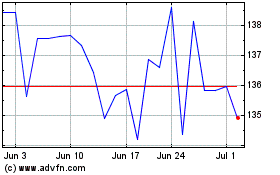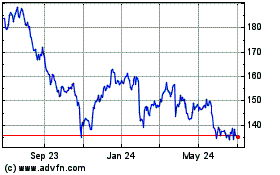UPS Reports Drop in Profit, Says Weather Hurt Results in U.S. -- Update
April 25 2019 - 9:59AM
Dow Jones News
By Paul Ziobro
United Parcel Service Inc. posted a lower profit in the first
quarter as upgrades to its parcel delivery network proved no match
for Mother Nature.
The delivery giant said it incurred about $80 million in extra
costs associated with dealing with severe winter weather in the
U.S., causing operating profit to fall 12% in its main business
unit.
Overall profit fell about 17% to $1.11 billion compared with the
same period last year, while revenue rose slightly to $17.16
billion.
UPS is spending billions of dollars to upgrade its delivery
network with more capacity, automated facilities and new technology
that can reroute packages around congestion. The company says those
measures are helping to control costs as it handles the vast
amounts of e-commerce packages that move through its facilities and
on its trucks.
"We are bending the cost curve in our U.S. domestic segment as
highly automated hubs come online, producing improved productivity
benefits," Chief Executive David Abney said.
UPS's new strategy also includes chasing business that yields
greater profits, including small- and medium-size business and
health-care shipments. In the latest period, UPS said it grew its
business-to-business deliveries, which are generally more
profitable, once again. It also said that the small- and
medium-size shippers increased returns by a double-digit percent
range in the months after the December holidays.
Mr. Abney said that while Amazon.com Inc. is bringing some of
its delivery volume in-house, it's not affecting the company's
shipping volume. "While we continue to focus on servicing their
needs, there is so much more to e-commerce than Amazon," Mr. Abney
said.
In the company's international business, operating profit fell
11% on a 2.1% decline in revenue. Its smaller supply chain and
freight unit logged a 17.6% increase in profit, even as revenue
fell nearly 4%.
While UPS backed its guidance for the year, the company said
that its adjusted per-share earnings growth will be relatively flat
in the current quarter compared with a year earlier due to pension
financing costs. It will also open about 30% of its new network
capacity for the year in the second quarter, causing startup
costs.
That will push most of UPS's earnings growth into the back half
of the year. Citi analyst Christian Wetherbee said that "will
likely not resonate well with investors as it appears we need to
wait further for transformation, placing increasing risk on the
always challenging holiday quarter."
UPS will have less of a tailwind from growing economies to back
its business. Mr. Abney said that global economies, including the
U.S., are growing at a slower rate than last year. Trade
uncertainty is also causing jitters and some companies are
adjusting their supply chains as a result.
"The China-U.S. trade uncertainty is prompting softer industry
forecasts in the region," Mr. Abney said.
For the period, UPS reported earnings of $1.28 a share, down
from $1.55 a share. On an adjusted basis, UPS said earnings were
$1.39 a share. Analysts polled by Refinitiv were expecting $1.41 a
share.
--Allison Prang contributed to this article.
Write to Paul Ziobro at Paul.Ziobro@wsj.com
(END) Dow Jones Newswires
April 25, 2019 09:44 ET (13:44 GMT)
Copyright (c) 2019 Dow Jones & Company, Inc.
United Parcel Service (NYSE:UPS)
Historical Stock Chart
From Mar 2024 to Apr 2024

United Parcel Service (NYSE:UPS)
Historical Stock Chart
From Apr 2023 to Apr 2024
